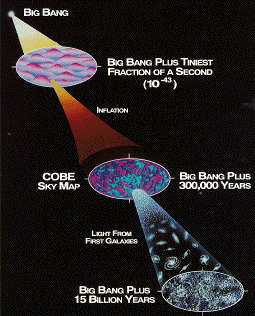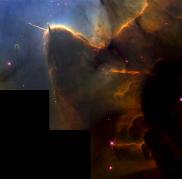In a Changing Universe
'Survivor' Planets: Astronomers Witness First Steps
of Planet Growth - And DestructionIn a detailed review of research in this century concerning the evolution of galaxies, Alan Dressler (Carnegie Observatories Pasadena, US) makes the following points:
(1) When the century opened, most astronomers assumed the Universe was eternal and basically changeless, its general structure immutable. In 1915, with the publication of Einstein's general theory of relativity, there were implications of the cosmic role of gravity, but these implications were for the most part ignored. Indeed, even after 1924 and the proof by *Edwin Hubble (1889-1953) that the spiral nebulae are other galaxies at vast distances, astronomers were slow to recognize the implications of the new observations.
(2) The first big step in changing the view of the cosmos was the construction by *George Ellery Hale (1868-1938) of the 100-inch Hooker reflector on Mount Wilson (US), a project completed in 1918. This was the telescope used by Hubble and his colleagues to reveal the large-scale organization of the Universe into galaxies, the vast size of the Universe, and the expansion of the Universe. *George Lemaitre (1894-1966) soon proposed that the expansion of the Universe implied a dense explosive birth of the Universe at a specific finite time in the past (the event that came to be called the Big Bang).
(3) An even greater telescope was needed, and again George Hale led the way in the building of the 200-inch reflector on Palomar Mountain (US), that instrument finally completed in 1948. The 200-inch telescope produced the first observations of galaxy evolution -- the first evidence that galaxies observed at high *redshift are unlike galaxies closer to us in time. An even greater accomplishment of the 200-inch telescope was a series of observations concerning the spectra of *quasars, and the evidence for their immense distances and luminosities. Theorists eventually proposed that quasars were *black holes of 100 million solar-masses or more. It is now clear that most galaxies with a central bulge, including our own Galaxy, harbor massive black holes at their cores.
(4) In 1961, Allan Sandage published a landmark paper outlining the possibility of testing cosmological models with the 200-inch telescope, and over the next two decades Sandage devoted himself to this project. Unfortunately, the underlying premise of the project -- that the brightest galaxy in every galactic cluster has about the same true luminosity -- was demonstrated by *Beatrice Tinsley (1941-1981) to be untenable.
(5) In the fall of 1977, at a Yale University (US) conference on the evolution of galaxies, Harvey Butcher and Augustus Oemler presented their evidence for relatively young star-forming galaxies. This evidence, which implied strong galaxy evolution during relatively recent cosmic time, met with controversy and skepticism.
(6) In the 1980s, observations by various groups proved that Butcher and Oemler were correct, and it was now understood that these relatively young galaxies were often producing new stars in huge bursts. These bursting galaxies are evidently spirals with a more disheveled appearance than is common today, and in their twisted and distorted disks huge numbers of stars were recently born.
(7) During the past 2 years, among the most interesting results of various observations with various instruments is the formulation of the so-called Madau diagram (popularized by Piero Madau) that plots the Universe-wide rate of star formation from early times to today, spanning almost the whole history of the cosmos. The rate of star formation apparently rose rapidly in the first few billion years, the peak rate at about 5 or 6 billion years later at redshifts of 1 to 2. (Our Sun apparently formed at a time corresponding approximately to redshift = 0.5.) The author concludes: "Our generations are fortunate to live to see one of the great mysteries of where we came from in process of being solved."
QY: Alan Dressler, Carnegie Observatories, Pasadena, Ca. US.
(Sky & Telescope October 1998)
Related Background:
*Edwin Hubble (1889-1953):
Hubble first studied law before switching to astronomy at the age of 25. He began his work at the Mount Wilson Observatory with the 100-inch telescope at the age of 30. In 1941, at the age of 52, he tried to join the US Army to fight the Nazis, but he was persuaded that he could do more in war-related research.
*George Ellery Hale (1868-1938):
Hale is best known for his work building large-telescopes (and for obtaining the funds for the Yerkes Observatory, named after the street-car magnate Charles Tyson Yerkes), but already at the age of 21 he invented the spectroheliograph, a device that made it possible to photograph the light of a single spectral line of the sun, and he made several ground-breaking observations with this instrument.
*George Lemaitre (1894-1966):
Lemaitre began his professional life as a civil engineer, then at 21 he switched to physics and mathematics. He also became a Roman Catholic priest at the age of 22. After obtaining his PhD at the Massachusetts Institute of Technology in 1927, he settled in Belgium as a professor of astrophysics at the University of Louvain. At the time of his death, he was president of the Pontifical Academy of Sciences at Rome. Lemaitre's theoretical ideas concerning the origin of the Universe were published in 1927, when he was 31, but the paper was largely unnoticed until the astrophysicist Arthur Eddington (1882-1944) called attention to it much later.
*redshift: Redshift (symbol: z)
is a lengthening of the wavelengths of electromagnetic radiation from a source caused either by the movement of the source (Doppler effect) or by the expansion of the universe (cosmological redshift). Redshift is defined as the change in wavelength of a particular spectral line divided by the unshifted wavelength of that line. Large redshifts imply large radial velocities (which imply large distances, according to current cosmological theory), but at redshifts greater than about 0.2 there is a relativistic divergence from a linear relation. A redshift of 4.0 corresponds to an object receding with a radial velocity 92% that of the velocity of light. The largest astrophysical redshifts so far observed are of the order of z = 4.9.
*quasars: (quasi-stellar objects)
Extremely luminous sources radiating energy over the entire spectrum from x-rays to radio waves, and which are apparently the oldest and most distant objects in the universe.
*black holes:
If the terminal stages of star death leave a remnant star mass greater than 3 solar-masses, the ultimate gravitational collapse will produce a black hole, a relativistic singularity.
A black hole is a localized region of space from which neither matter nor radiation can escape. The "trapping" occurs because the requisite escape velocity, which can be calculated from the relevant equations, exceeds the velocity of light and is therefore unattainable.
Another view of a black hole is that it is a mass that has collapsed to such a small volume that its gravity prevents the escape of all radiation. Space and time essentially have no meaning in a black hole. The boundary of the black hole is called the "event horizon", because any event within the boundary is invisible outside, the invisibility resulting from the fact that no radiation can escape to be detected.
The radius of the black hole depends upon how much matter has fallen into the region; it is called the "Schwarzchild radius", and it is usually a few kilometers. However, massive black holes are possible and are thought to be the source of quasars. If quasars indeed involve black holes, the radiation is from material just outside the black hole, and not from anything within it. Nothing inside a black hole can get out of it.
*Beatrice Tinsley (1941-1981):
During her short life, Tinsley managed to be a force in astronomy from her first entry into the field. At the age of 25, an unknown graduate student at the University of Texas, she rose before an audience about to hear Allan Sandage and publicly challenged his idea that giant elliptical galaxies exhibited luminosities constant enough to be used as "standard candles" to estimate distances. She proved her point by the age of 36, and the variability of galaxy luminosities became the consensus view. It was Tinsley who co- hosted the 1977 Yale conference that set the course of galaxy- evolution studies. She died 4 years later of cancer. Near the end, she wrote the following: "Let me be like Bach, creating fugues; till suddenly the pen will move no more."
ON THE FORMATION OF ELLIPTICAL GALAXIES
The furthest galaxy on record is at a redshift z = 4.92), which implies a distance of approximately 13 billion light years (i.e., an object date of 13 billion years ago.)
The term "near infrared" refers to the range 0.8 to 8 microns. Now S. Zepf (Univ. of California Berkeley, US) reports an analysis of deep optical and near-infrared images indicates there are fewer galaxies with very red colors than predicted by models that propose completion of elliptical galaxy star formation by approximately z = 5. This suggests that elliptical galaxies must have significant star formation at z [ 5. The author proposes that either ellipticals form at moderate redshifts, where a large initial burst of star formation is shrouded by dust, or that they form through the merging of smaller galaxies.
QY: Stephen A. Zepf [zepf@astro.yale.edu] (Nature 27 Nov 97)
ASTRONOMERS AGREEING ON THEORY OF GALAXY FORMATION AND EVOLUTION
Among contemporary cosmologists, there are two prevailing models for the formation of galaxies. One model is hierarchical, in the sense that small amorphous proto-galaxies are considered to form first, these evolving into spiral galaxies, and the spiral galaxies then merging to form elliptical galaxies.
The other model is a completely different picture, considering the various galaxies to form from the condensation of single massive dust clouds, with the particular type of galaxy formed dependent on the nature of the dust cloud collapse.
At two recent cosmology symposia, in view of new red-shift data (shifts to the red end of the spectrum of light from the galaxies) provided by the Hubble Space Telescope, cosmologists are apparently forming a consensus that the first idea, the hierarchical model, is more consistent with the observed data than the second model. The Hubble Space Telescope has brought a renaissance to cosmology, and we are only at the beginning of the new era.
(Nature 26 Jun 97)
STAR FORMATION
Education 2001 - HowComYouCom.com

